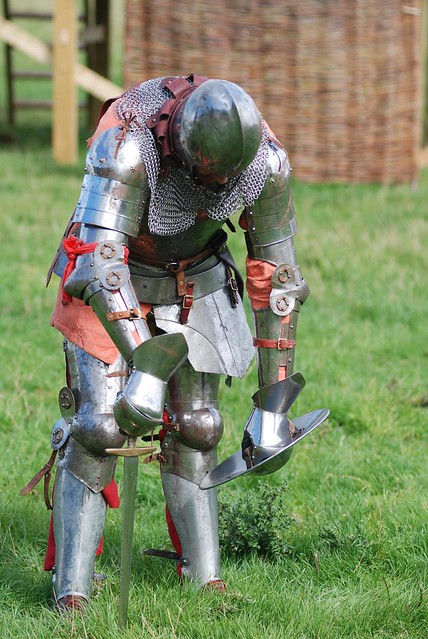One handy element of D&D 5th Edition is the concept of conditions. By codifying specific ways that a creature can be hampered, the designers took a significant cognitive load off of designing hazards and debuffs and made the rules more consistent. Most of the conditions are straightforward, with static penalties that apply when a creature is afflicted with the condition (potentially including other conditions) but one stands out as an exception to this general rule: exhaustion, which is unique in that it comes in levels, as we see below.
This is the part of a weekly series of articles by a team of designers answering D&D questions for beginners. Feel free to discuss the article and add your insights or comments!

Gaining Exhaustion in Play
Exhaustion is typically encountered when characters are traveling and/or in a wilderness survival situation.
Remember, with exhaustion the levels are cumulative. So for example, a character with four levels of exhaustion has their maximum hit points halved, disadvantage on attack rolls and saving throws, their speed halved, and disadvantage on ability checks.
Each time a creature gains a level of exhaustion, they apply the penalties from the new level of exhaustion to those they already have. So in the above example, if the poor character gained another level of exhaustion, their speed would be reduced to zero (half of which is also zero; no need to worry about effects being superceded).
It doesn’t take a rules expert to see that this condition can quickly become debilitating and is best avoided if possible. Exacerbating this, getting rid of exhaustion is not typically something that can be done quickly. In the D&D core rules, there are only few ways, in fact:
The effects of removing exhaustion work like gaining it, but in reverse, with the highest level of exhaustion removed first and with it, the associated effects. So if the character with four levels of exhaustion above completed a long rest and ate a meal, they would have their hit point maximum restored (and would recover those hit points as part of that rest). If they or another creature then cast greater restoration on them, they would no longer have disadvantage on attack rolls and saving throws.
Nuances of the Exhaustion Rules
You may have heard that characters with six levels of exhaustion can't come back. Is this true? Well, it sort of was, but not any more.
None of the resurrection spells (revivify, raise dead, etc.) specify anything about removing exhaustion, which means that the condition persists on even a dead character. So you could bring a terminally-exhausted character back to life, but then the exhaustion levels would immediately apply and they'd instantly die again. Talk about "dead tired."
Fortunately, WotC fixed this with some errata for the PHB back in 2018. Being raised from the dead now removes a level of exhaustion. So a character that dies from exhaustion is still going to come back with five levels and need a long period of rest (or need five castings of greater restoration, or a potion of vitality) to get back to zero levels of exhaustion.
Other edge cases to keep in mind: a character that goes from four or more levels of exhaustion to three or fewer via a long rest will finish the rest with their full (normal) hit points, but one who sheds their exhaustion via spell or magic item will have their maximum restored to its normal level, but will not automatically recover any missing hit points and will need to get them back some other way.
A creature with three levels of exhaustion has disadvantage on death saves and concentration checks. A creature with even a single level of exhaustion will have disadvantage on initiative (initiative is an ability check, as are all skill checks).
Adding More Nuance to Exhaustion
If you want some more granularity in your exhaustion rules, check out Level Up (Advanced 5e), coming this fall from EN Publishing. Level Up splits exhaustion into fatigue (physical exhaustion) and strife (mental exhaustion), each of which can advance separately, with different effects for each track, and tighter integration into combat and journeys.
This is the part of a weekly series of articles by a team of designers answering D&D questions for beginners. Feel free to discuss the article and add your insights or comments!
Exhaustion
Some special abilities and environmental hazards, such as starvation and the long-term effects of freezing or scorching temperatures, can lead to a special condition called exhaustion. Exhaustion is measured in six levels. An effect can give a creature one or more levels of exhaustion, as specified in the effect's description.
If an already exhausted creature suffers another effect that causes exhaustion, its current level of exhaustion increases by the amount specified in the effect's description.
A creature suffers the effect of its current level of exhaustion as well as all lower levels. For example, a creature suffering level 2 exhaustion has its speed halved and has disadvantage on ability checks.
An effect that removes exhaustion reduces its level as specified in the effect's description, with all exhaustion effects ending if a creature's exhaustion level is reduced below 1.
Finishing a long rest reduces a creature's exhaustion level by 1, provided that the creature has also ingested some food and drink.
Some special abilities and environmental hazards, such as starvation and the long-term effects of freezing or scorching temperatures, can lead to a special condition called exhaustion. Exhaustion is measured in six levels. An effect can give a creature one or more levels of exhaustion, as specified in the effect's description.
| Level | Effect |
|---|---|
| 1 | Disadvantage on ability checks |
| 2 | Speed halved |
| 3 | Disadvantage on attack rolls and saving throws |
| 4 | Hit point maximum halved |
| 5 | Speed reduced to 0 |
| 6 | Death |
If an already exhausted creature suffers another effect that causes exhaustion, its current level of exhaustion increases by the amount specified in the effect's description.
A creature suffers the effect of its current level of exhaustion as well as all lower levels. For example, a creature suffering level 2 exhaustion has its speed halved and has disadvantage on ability checks.
An effect that removes exhaustion reduces its level as specified in the effect's description, with all exhaustion effects ending if a creature's exhaustion level is reduced below 1.
Finishing a long rest reduces a creature's exhaustion level by 1, provided that the creature has also ingested some food and drink.
Gaining Exhaustion in Play
Exhaustion is typically encountered when characters are traveling and/or in a wilderness survival situation.
- The two most common sources of exhaustion are failing the Constitution saving throws imposed by forced marches or inadequate food and water.
- Several diseases such as cackle fever and sewer plague can also cause exhaustion.
- As referenced in the rules entry itself, environmental conditions can also cause it.
- Occasionally a class ability will also inflict exhaustion.
- Other sources may exist depending on what supplemental rules are being used.
Remember, with exhaustion the levels are cumulative. So for example, a character with four levels of exhaustion has their maximum hit points halved, disadvantage on attack rolls and saving throws, their speed halved, and disadvantage on ability checks.
Each time a creature gains a level of exhaustion, they apply the penalties from the new level of exhaustion to those they already have. So in the above example, if the poor character gained another level of exhaustion, their speed would be reduced to zero (half of which is also zero; no need to worry about effects being superceded).
It doesn’t take a rules expert to see that this condition can quickly become debilitating and is best avoided if possible. Exacerbating this, getting rid of exhaustion is not typically something that can be done quickly. In the D&D core rules, there are only few ways, in fact:
- Resting and the greater restoration spell, each of which only remove one level of exhaustion at a time.
- Those using the DMG can also benefit from the rare potion of vitality, which removes all exhaustion, poisons, and diseases from a character who drinks it.
- Being raised from the dead (see below).
The effects of removing exhaustion work like gaining it, but in reverse, with the highest level of exhaustion removed first and with it, the associated effects. So if the character with four levels of exhaustion above completed a long rest and ate a meal, they would have their hit point maximum restored (and would recover those hit points as part of that rest). If they or another creature then cast greater restoration on them, they would no longer have disadvantage on attack rolls and saving throws.
Nuances of the Exhaustion Rules
You may have heard that characters with six levels of exhaustion can't come back. Is this true? Well, it sort of was, but not any more.
None of the resurrection spells (revivify, raise dead, etc.) specify anything about removing exhaustion, which means that the condition persists on even a dead character. So you could bring a terminally-exhausted character back to life, but then the exhaustion levels would immediately apply and they'd instantly die again. Talk about "dead tired."
Fortunately, WotC fixed this with some errata for the PHB back in 2018. Being raised from the dead now removes a level of exhaustion. So a character that dies from exhaustion is still going to come back with five levels and need a long period of rest (or need five castings of greater restoration, or a potion of vitality) to get back to zero levels of exhaustion.
Other edge cases to keep in mind: a character that goes from four or more levels of exhaustion to three or fewer via a long rest will finish the rest with their full (normal) hit points, but one who sheds their exhaustion via spell or magic item will have their maximum restored to its normal level, but will not automatically recover any missing hit points and will need to get them back some other way.
A creature with three levels of exhaustion has disadvantage on death saves and concentration checks. A creature with even a single level of exhaustion will have disadvantage on initiative (initiative is an ability check, as are all skill checks).
Adding More Nuance to Exhaustion
If you want some more granularity in your exhaustion rules, check out Level Up (Advanced 5e), coming this fall from EN Publishing. Level Up splits exhaustion into fatigue (physical exhaustion) and strife (mental exhaustion), each of which can advance separately, with different effects for each track, and tighter integration into combat and journeys.





